Why do you even need a power meter on your bike? Is it the holy grail to fitness? What are the available options and how much do they cost?
I've owned an Ergomo, Powertap and SRM. The SRM seems to be acknowledged as the best, but is that title deserved, based on the metrics? There are new products on the market which are bringing the price down while increasing available data and accuracy.
I've owned an Ergomo, Powertap and SRM. The SRM seems to be acknowledged as the best, but is that title deserved, based on the metrics? There are new products on the market which are bringing the price down while increasing available data and accuracy.
The first question to ask yourself is why you need a power meter. After all, even the cheapest is quite expensive and most training can be done with heart rate or by feel.
I have an SRM power meter and with it I can track fitness and training stress. It takes away some unknowns. Just measuring your heart rate or time (e.g. Strava) does not give the full picture. The air density can vary by 10% between a warm and cool day, for example. The wind might be favorable. And as for heart rate, it can fluctuate due to hydration, fatigue or too many beers the night before!
For serious training, a power meter is a great tool. On the other hand, I know of top riders who barely look at the power meter. For example, leading UK pro Marcin Bialoblocki is currently training in 2014 with only heart rate. And now that I've used a PM for the last 6 years, I probably know enough to do most of my training without one too.
Tip: If you are always staring at your Wattage, then try a few weeks without it. Just ride on feel. Race - concentrate on the competition rather than glancing down at heart rate. It is liberating.
On top of the expense, the things are always breaking, regardless of brand, so you spend a lot of time waiting for a replacement or fiddling with electronics. It might be less stressful to just go out and ride.
How can a power meter help in terms of getting fitter?
Track progress
You can measure maximum power for different periods of time, such as 5 seconds, 1 minute, 5 minutes and 20 minutes (also known as critical power - CP). Your speed might go down due to cold or wind, but if your power has increased, you know you have improved.
Track fatigue
With WKO+ software, you can track your training load so you can see how fresh you should be or how wrecked you should be! Sometimes it is hard to listen to your body. The normal mistake is to keep training hard until you get sick. With the software you can see if your load is high, so can back off without feeling guilty.
Identify weak or strong points
You might find you are great at sprinting, but if you have a low threshold, you'll be left gasping before the sprint starts. You can then set about training those weak areas so you can make use of your strong point. You will also be able to judge your fitness compared to professionals. For example, if you can hold 6.5 W/kg for 20 minutes you could make the podium in the Tour de France!
Helps you to ride more gently on off days
Most of us have trouble riding gently, especially when the sun is out and someone rides past. If you know you need to ride gently, then the power meter will keep you from going too hard on your easy days.
Helps with pacing
The fastest way to ride a time trial is generally to keep a constant power from start to finish. Your body is not very good at telling you what that is, so normally you will start off far too hard and pay the price later, resulting in a slower time than you are capable of. A power meter will keep you in check at the start. (At the end you will be too cross eyed to look at it - just ride hard!)
It is not so useful in a road race as when establishing a break you just need to go flat out. If you looked at your heart rate when doing that you'd probably freak out. However the data is great to look at afterwards.
Complete record of your ride
Invaluable to review what happened when you got dropped and also to send to a coach. If you know the coach will see the files then you are more likely to complete the workout.
Power meter features
Price
For most people this is an important factor. If you could buy an SRM, perhaps you are better off buying three Stages devices? Also consider the cost of service. SRM is the worst in this case, as even battery changes need to be done by SRM service.
Weight
Weight is always something that every cyclist thinks about, especially as power meters are all rotating weight. The additional weight of the power meter ranges from 208g with the SRM to under 20g for the Stages. 200g won't really make much difference on most rides, but would equate to about 20s up Alpe D'Huez.
L-R measurement
Some manufacturers are offering this metric. My feeling is that there's already data overload with Watts, heart rate, speed, GPS. LR balance isn't that much of a concern. It certainly isn't to the Stages crew.
L-R balance could be nice to see a few times, especially after injury. The Pioneer device gives very detailed analysis of the entire pedal stroke, and can show where one leg is working against the other (pressing down on the upstroke). Correcting this would go a long way to increasing performance. Smooth and experienced pedalers probably don't need it.
What else do I need to buy?
Some units are supplied without head units. Since many cyclists already have an ANT+ device like a Garmin 500, this probably isn't much of an issue. Some units require purchase of cranks, chainrings, perhaps a new bottom bracket. Study the requirements carefully before ordering.
Accuracy
This is difficult to judge. They all claim to be at least 2% accurate. It seems that some units may drift badly when exposed to temperature fluctuations, despite an apparent auto-zero, although it also seems that by Mar 2014 the manufacturers below have resolved major issues. They all work well out of the box, but the challenge comes 5 months later during a wet winter. If you become used to training with power, a broken PM becomes stressful. Silly, I know - just get out and ride, but pacing intervals on a turbo trainer suddenly becomes much harder. It is worth the extra outlay to reduce this worry.
If you've decided you want one, then here's a list of the main models. There is a summary table at the end.
SRM
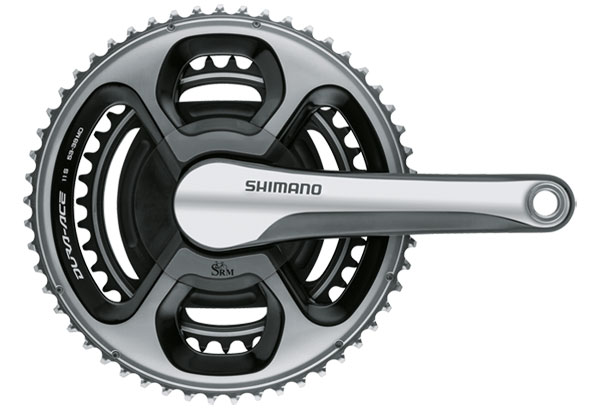
SRM Dura-Ace 7900 11 speed. The most mature power meter and a favorite with pro riders. Generally reliable, accurate and long lasting. However it is the heaviest, expensive to buy and maintain and lacks certain features that other power meters now offer.
This is the first power meter brand, from around 1986. As a result, the design appears to be the most mature and reliable. Strain gauges in the crank measure the force, and this data is sent wirelessly to the head unit.
These power meters seem to work reliably for years. Worst case is to replace the electronics, which SRM service can do (cost about $600). SRM service also need to replace the batteries for you, which is expensive and inconvenient (about $100 + calibration). When the battery is replaced, the zero offset may need to be adjusted, perhaps every three changes. You will need an oscilloscope to get the correct offset. It's not as easy as pushing a button, so should be done at an SRM service center.
SRMs are high quality and robust, which is why people love them.
SRM adds the most weight to your bike compared to other power meters: 208g over a normal Dura-Ace crank.
Pros: reliable, accurate, easy to swap between bikes. The most bling power meter to have on your bike.
Cons: Expensive, heaviest power meter, doesn't auto-calibrate due to temperature, doesn't do L-R, unit has to be sent for expensive battery replacement, no GPS in the head unit (although this is coming with the PowerControl 8, December 2014 or pair it with a Garmin). Software is free but adequate. Better to buy WKO+

The new SRM PowerControl 8 (PC8) head unit. It features 30 hours of battery life with GPS on, 150 hours with GPS off, it beeps, the display may be customized, new magnetic USB cable.
90g, GBP550, available December 2014.
Expensive, but very desirable.
90g, GBP550, available December 2014.
Expensive, but very desirable.
Powertap
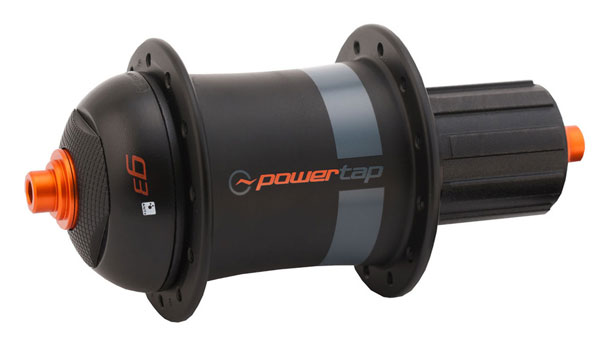
Powertap G3 hub by Cyclops. Now a mature product. The older models suffered from reliability issues but this has been largely resolved. The electronics are housed in the plastic cap, so you don't need to send the whole hub back if they need to be repaired.
This unit positions strain gauges in the rear hub. In the past this meant you had a heavy back wheel as the rear hub was about 400g heavier than a standard hub. However with the Powertap G3 at 315g, the weight penalty is only 55g, which is peanuts.
Powertap sell an ENVE 3.4 clincher wheelset with the G3 power meter which weighs 1593g. It will also make your wallet light at $3,200, but if you were going to get ENVE wheels anyway, then the difference isn't that much.
The only issue is that you end up with a a racing wheel you don't want to use for training (or vice-versa). Those carbon rims won't last forever! For triathletes and time trialists, unless you buy a disk with a powertap, you can't use your PM in a race. Tri/time trial is a perfect time to have PM data available for pacing, as mentioned above.
Reliability has been an issue in the past (pre 2010). They seem to be particularly prone to failure when used in wet weather. The bearings pit, torque tubes break and the electronics fail. Generally, warranty and service is good. As of 2014 this may have been resolved. The electronics have been relocated into the plastic cover so you don't need to send the whole wheel back for service.
On the up side the price is reasonable, and they work perfectly well on the turbo and in dry weather.
Pros: relatively cheap, hubs for sale under $800. With the G3 this is now a light solution. Accurate and easy auto-zero. Good service.
Cons: you are limited to a particular wheel but you can afford to get two for the price of competitors, possible reliability issues. The head unit is not that great. Better to use a Garmin. The software is adequate - you need to get WKO+
Quarq
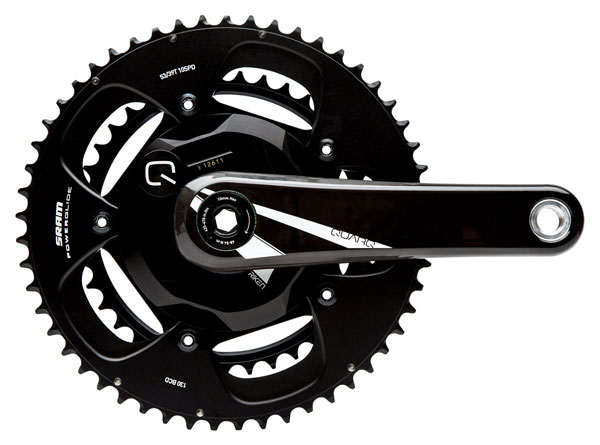
Less reliable than SRM from anecdotal evidence, but service quality is good.
Quarq is owned by SRAM so has substantial backing. As of 2014 the models are the Riken and the Elsa. The Riken is the SRAM branded crank and the Elsa is Quarq branded for Shimano and Campagnolo users. It works in a similar way to the SRM, in that it has strain gauges in the crank.
It is cheaper and lighter than the SRM, but reliability is questionable. My local bike shop reckons they had about 75% of units returned due to malfunction of strain gauges or electronics. One rider's Quarq broke three times. Each time he was sent a new replacement. When he received the third replacement he sold it and bought an SRM, which he's been happy with.
Pros: moderate price (about half that of SRM's top model), easy to swap between bikes.
Cons: Heavy - although lighter than SRM. (823g v 858g), won't work with Shimano Hollowtech II bottom brackets, lack of crank length availability, anecdotal evidence suggests that reliability could be an issue.
Stages
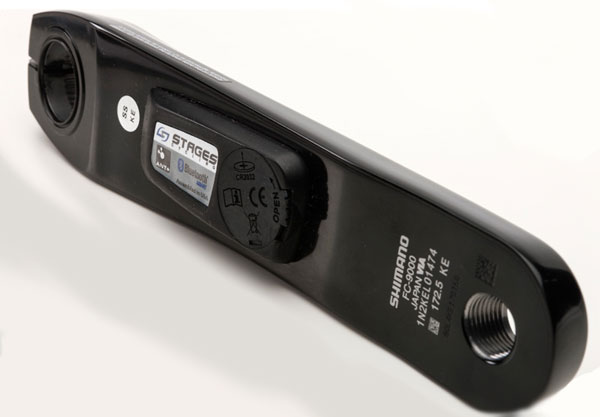
Stages is a newcomer to the power meter market. A few initial kinks with the battery door have been ironed out. (The door was falling off and also leaking). The unit is light and relatively cheap. It does only measure power from the left leg, but team Sky are using it so perhaps it is OK. The simplicity of the design means that the readings from the L leg should be accurate, with stages claiming +- 2W at any power. So if you are tapping out 400W, that's only +- 0.5%.
This is a new power meter which was released in 2012. In 2014 it is the official power meter of team Sky. So you're probably thinking what I'm thinking, which is 'if it is good enough for Sky then it is good enough for me'.
Reviews appear to find the data reasonably similar to that of other power meters, although there have been some reliability issues with the waterproofing of the electronics. These issues are being solved now. The extra weight is only <0.7oz / <20g compared to a standard crank, and the price is very reasonable. It only measures power from the left leg and doubles it, so power readings may be incorrect for those with discrepancies between legs. There is some concern that such a system might subconsciously teach you to pedal harder with your left leg.
Pros: reasonable price, easy to swap between bikes, light, good service
Cons: some product issues in 2014, only measures left leg.
Power2Max
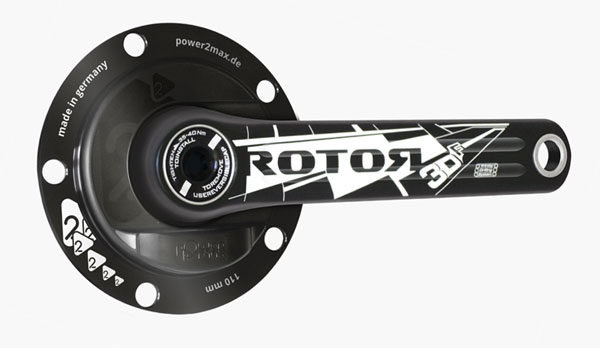
Power2Max is a German company, and as expected their engineering has been impeccable. I've heard nothing but good reviews about these power meters and I would seriously consider this as an alternative to the SRM. Used by Movistar team.
I know a couple of people who have these and they say they're fantastic. They are made in Saxony, Germany, and use the same technology as SRM, as the SRM patent has expired. The system works with strain gauges in the cranks. The electronics are water sealed with poured plastic.
Like the SRM, it appears to do the job with minimal fuss and at a reasonable price ($1300 includes cranks but no rings or head unit). They are a little bit lighter than SRM. You can replace the battery yourself, and it should last 300-400 hours. Accuracy is better than 2%. One of the best features is that the system will accurately auto-zero. This was tested by cooling the unit to 5C in a fridge, then riding it on a bike with a powertap at room temperature. The unit was able to successfully recalibrate itself.
You can only buy these units online at the Power2Max website. Pro team Movistar is using them in 2014.
Pros: Reliable, reasonable price, easy to swap between bikes, no magnets to install, calibrates to temperature, user can swap battery.
Cons: Not as well established as SRM.
Garmin Vector
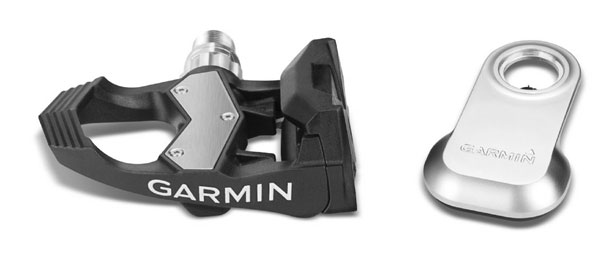
Garmin did well by waiting until the product was reliable before releasing it to the market. It is a good idea to have power measured at the pedals, but I worry about the longevity of the bearings. Would these pedals last 10 years?
This is a new pedal-based system. It is light, portable between bikes, measures left and right leg power and of course, you can change the batteries yourself. However, it is probably most susceptible to crash damage as the pedals always make contact when the bike is dropped. Garmin have worked hard to provide protection for the sensors, but I can't help thinking about the impact pedals can get.
The pedals are manufactured by Exustar and have had extra material added to help protect the strain gauges in the axle. Regardless, bearings will wear, especially if being run in the rain.
The unit took something like 4 years to get to market, but as a result the product appears to be reliable from the start. Well done Garmin for waiting to get it right.
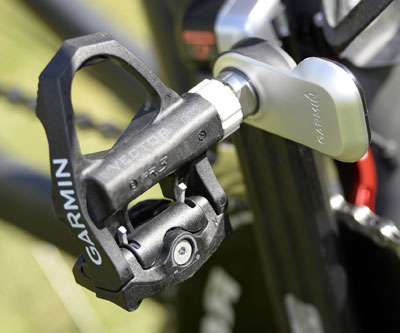
The Garmin Vector pedal system as installed on a Garmin pro team bike. Photo thanks to Cervelo marketing team.
Pros: Reliable from product launch, light, portable, L-R measurement, integrates well with Garmin units
Cons: Expensive, located in a place that's easy to damage, you are stuck with Exustar pedals which will wear. How long will the bearings last?
Polar/ Look
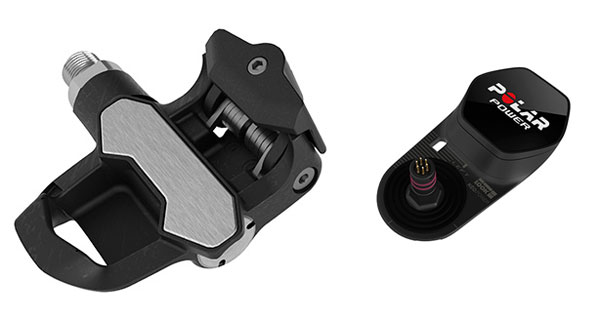
Look has teamed up with Polar to create these pedals. It is nice looking kit, but seems to be a little unfinished - who wants a zip-tie on their crank? The Polar computer isn't very good and service seems to be an issue as the pedals need to be serviced by Polar and Look. I also find the Keo cleats wear out quickly.
This product isn't quite up to standard yet. For example, you need to zip-tie the electronics to the crank arm. Adjustment of the spindle angle is fiddly (like the Ergomo BB), you can only record for about 6 hours and the head unit is poor (and you can't swap it for any ANT+ unit). You are stuck with Look pedals and the servicing is slow since it needs to go to Polar and Look. On the positive side, it is light, and does measure L-R balance.
Online reviews are not looking favorable at Mar 2014, calling product reliability into question. Hopefully this will be addressed with a future release.
I've got nothing against Look pedals, but I've found that the bearings get loose or rough after a few wet rides, and the cleats wear out really quickly. The non-slip gripper just rips out of the cleat and then back of the cleat wears down. And that's with very little walking.
Pros: Light, L-R Balance, accuracy matches that of other systems
Cons: Expensive, slow to service, vulnerable position, zip-ties, stuck with Look pedal system, poor head unit, questionable reliability.
Pioneer SGY-PM910H

This power meter can provide a lot of information about your pedaling dynamics. However it is expensive and you need to supply your own cranks for the factory to fit to. And ... zip-ties (the V2 model has done away with zip ties).
Pioneer has produced a powermeter that has some interesting features. It provides very detailed analysis of the pedal stroke, and it is light. For example, you can see your right-left leg balance, and direction of force at every 30 degrees of the crank rotation. From this you can find out if your upward moving leg is working against your downward moving leg.
There seem to be a few disadvantages. One is the price, at $2500 you could buy 3 Powertaps (Note Version 2 is expected to be much cheaper). Second, there are zip-ties (Again in versin 2 these are to be removed and the unit will be glued to the cranks instead). Third, you need to get the unit installed by a special mechanic who will precisely glue it to your cranks and calibrate it. Forth, you can only use DuraAce 9000 or Ultegra 6800 cranks.
Pros: Fantastic data about pedal dynamics, light weight
Cons: Expensive (Ver 2 price to be reduced), zip-ties, install by mechanic, you can only use Shimano DA 9000 or Ultegra 6800 cranks.
Summary table of power meters
I have summarized some info about the power meters below. Prices are as of Mar 14.
Regarding added weight, I have compared the power meter weight to a component of similar type, for example Dura-Ace cranks, Look carbon pedals, Dura-Ace hub.
| Model | SRM DA9000 |
Quarq Riken 10S |
Stages Dura-Ace |
Garmin Pedals |
Look/ Polar Keo Power |
Powertap G3 |
Power2Max Type S Rotor 3D |
Pioneer SGY-PM910H |
|---|---|---|---|---|---|---|---|---|
| Price RRP $/GBP £ | $3145 / £2699 | $1595 / £1300 | $900 / £800 | $1699 / £1349 | $2300/ £1500 pedals only | $790 / £630 | $1299 / EUR 1110 | $1600 for PM, $900 head unit |
| Price on web |
$3295 Amazon.com |
$1396.31 at Amazon.com |
$900 but 105 and Ultegra are cheaper | $997.36 eBay seen,
$1699 on Amazon |
$1800 Amazon, includes head unit |
$400 eBay (new) | EUR 1110 tax free to USA | $1249.25 here (no head unit) |
| Weight/ g | 858g | 823g | 20g | 401g without cleats | 405g without cleats | 325g | 809g | 73g |
| Added weight compared to similar component/g | 208g | 174g | <20g | 146g | 150g | 55g | 160g | 73g |
| What else do I need to buy? | Head unit SRM $750 or Garmin 510 | Head unit e.g. Garmin 510 | Head unit e.g. Garmin 510 | Head unit e.g. Garmin 510 | Polar head unit CS600X approx $366-400 | Rim, spokes, cassette, head unit | Chainrings or $199 for Rotor | Head unit e.g. Pioneer SGX-CA900 $899, Dura-Ace Cranks |
| L-R stats? | N | N | N - only L leg | Y | Y | N | Y (L-R estimated) | Y |
| Auto-zero | Y but it isn't very good so N really | Y - back pedal | Y | Y | N - need to restart unit to zero | Y | Y - every time you stop pedaling | Y |
| User battery replace | N | Y | Y | Y | Y | Y | Y | Y |
| Easy to swap between bikes | Y | Y | Y | Y easier than LOOK to install | Y/N could swap the crank easily but not the PM | Y but limited to one wheel | Y | Y/N could swap the crank easily but not the PM |
| Requires cadence magnet | Y | Y | N | N | N | N | N | Y |
| Claimed accuracy | +- 2% | +- 1.5% | +- 2W although errors may arise from L-R imbalance | +- 2% | +- 2% | +- 1.5% | +- 2% | +- 2% |
| Type of system | Crank | Crank | Crank | Pedal | Pedal | Hub | Crank | Crank |
| Pro teams | Everybody at some point | Omega Pharma Quick Step 2014 | Team Sky 2014 | Team Garmin-Sharp | Bigmat Auber 93 | Lotto | Movistar 2014 | Orica, Belkin 2014 |
| Notes | Battery replacement costs about $100, plus postage and lost training time. | Questionabe reliability. | Check that your bike will allow the stages to fit - rear stays can have low clearance. | The pedal platform will wear out in 1-2 years. Look has a metal base to reduce wear. | Only compatible with Polar power meter, zip-ties to crank arm. Limited memory capacity in the head unit (6 hours). | Good service, electronics now easy to send for repair. | Can change chainrings without needing to re-calibrate. | Only compatible with Dura-Ace 9000 and Ultegra 6800 at Sep 2014. Should be installed by trained mechanic. |
Power meter Software
As important as the hardware is the software for analyzing your ride afterwards. I have used all of the packages below, since they are mostly free. However, the best one of all is WKO+ by Training Peaks.
WKO+ Training Peaks $129.00 (Mar 2014)
The easiest system to view your data. Easy to zoom in and out, set guide lines (e.g. at 200W), training stress scores are included (TSS, ATL, CTL) so you can easily view your fatigue/freshness. The software is well thought-out and intuitive to use.
This licence is perpetual and allows you to install the software on two computers. However it does come at a cost.
SRM Free
This is pretty good software; the second best after WKO+. The zoom function is a little clunky, as it opens a new tab every time. It can be difficult to zoom in exactly, so you end up opening a few windows. However it is really good for analyzing the data. The old version used to come with pro rider data, but they've since removed that.
PowerAgent 7 Cyclops Software - Free
The software is free to download from Cyclops (Powertap). It has been improved over the last few years, but the graphs are a little harder to interpret than with WKO+. There are fewer graphs available, and none of the training scores or critical power graphs which are useful to track progress.
Golden Cheetah Free
This software has improved a lot over the last few years. The source code is available so you could tweak the program if you are so inclined or able. The graphs are clear, but are harder to interpret due to lack of grid lines and ability to place guides. A lot of the useful graphs found in WKO+ are not present.
Garmin connect
This is an online tool, and free for Garmin users. I would rate it as similar to the Golden Cheetah or PowerAgent software in terms of graphs. You do get the GPS data too, which is fantastic.
Conclusion
I recommend training with a power meter (Wattage), as it takes away some unknowns. You might have ridden a worse time, but on analyzing the data you could see higher power. You now know that your form was not the issue (perhaps you went slower because of temperature, wind or your position got less aero). It makes riding intervals much easier.
However these devices are expensive, and it is stressful when they go wrong. And they all seem to go wrong!
I would like to recommend the SRM as the most reliable device, as that is common wisdom. However with other devices being cheaper to buy and maintain, lighter, more accurate, providing more data, then there is very little to justify an SRM purchase. I expect SRM to begin to lose market share to these competitors, but the market is expanding so they will be fine.
If you can live with data coming from the left leg only, (like Team Sky), I recommend the Stages. it is extremely light and is the cheapest device. You could buy two and still be saving money.
If you prefer a two-legged reading, then it would have to be the Power2Max.
The pedal-based systems are just a little too new right now, and I worry about bearing wearing out after 2-3 years.
The Powertap is an excellent product, but the issue here is about being stuck with one wheel, unless you buy training, race and disk versions.
It is worth paying for WKO+ software for serious analysis of your training.
Finally, make sure you take your power meter off for at least a month a year to experience the pure joy of riding your bike without staring at numbers.
Links
$3295 Amazon.com
$1396.31 at Amazon.com
The best book out there for powermeter users by Hunter Allen and Coggan Training and Racing with a Power Meter
Really nice book covering more topics than just power. Allen and Cheung Cutting-Edge Cycling
Google Groups Wattage forum - for all powermeter related issues. You need to request to join the group, but everything you need to know is on there. Probably too much detail sometimes.
